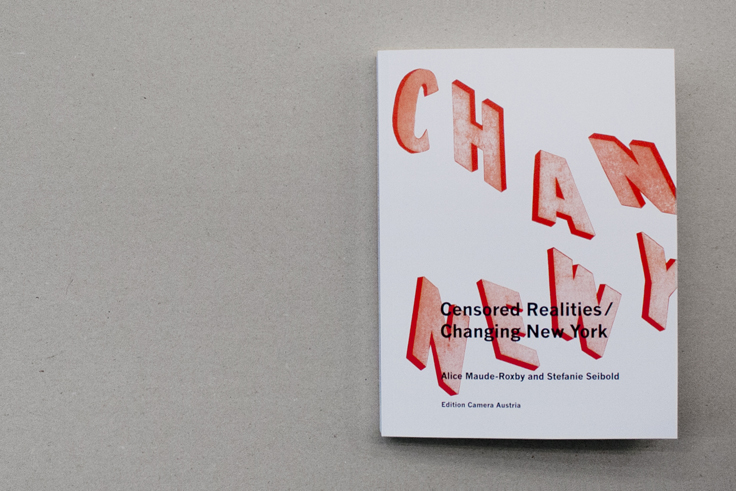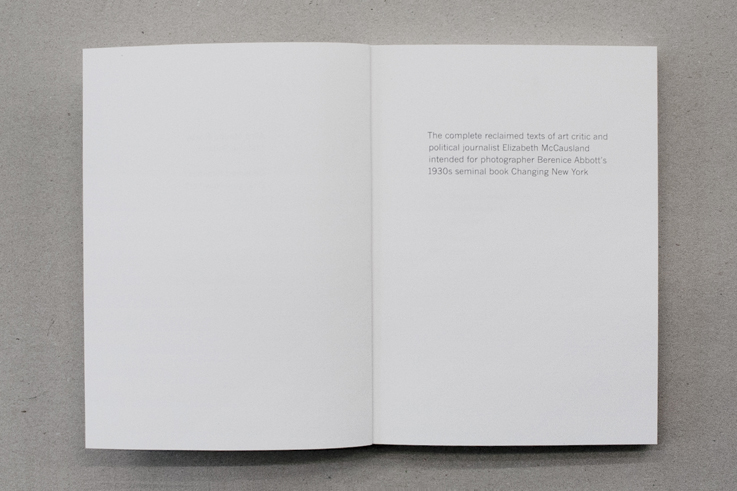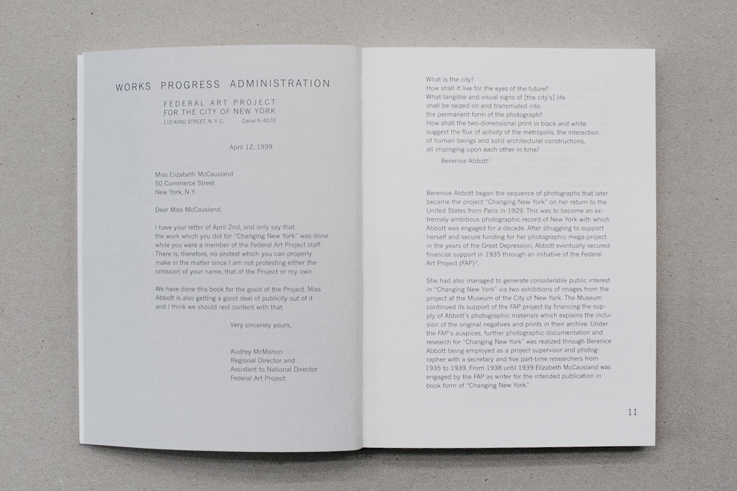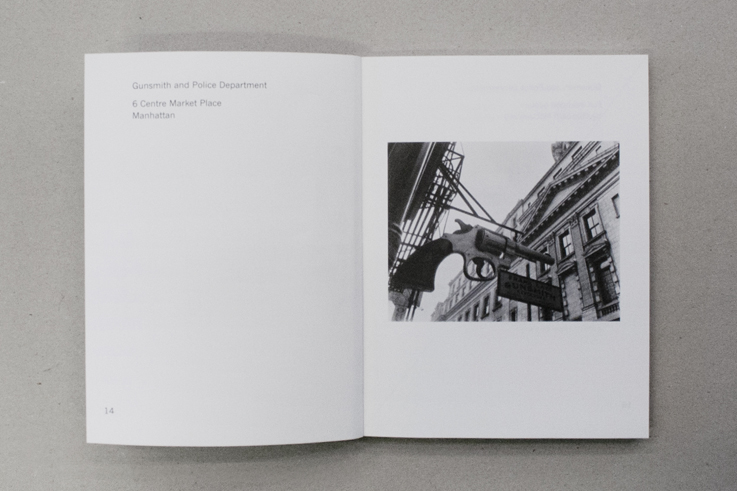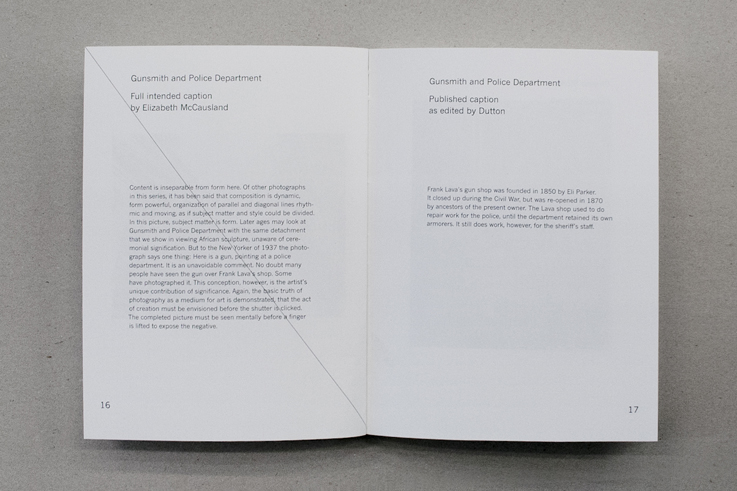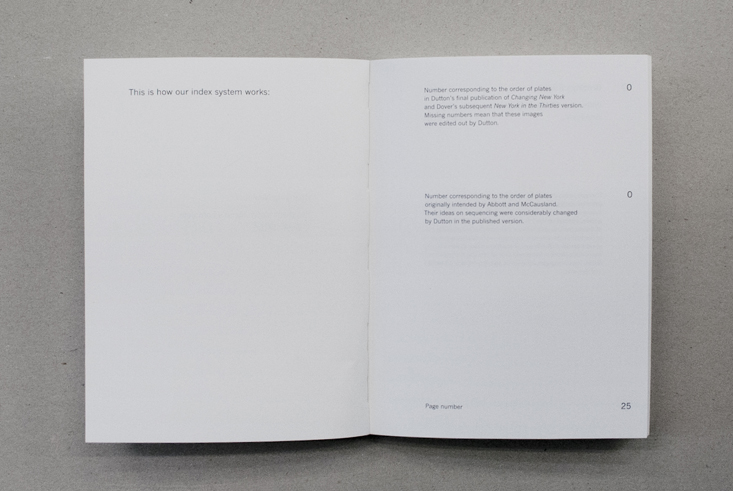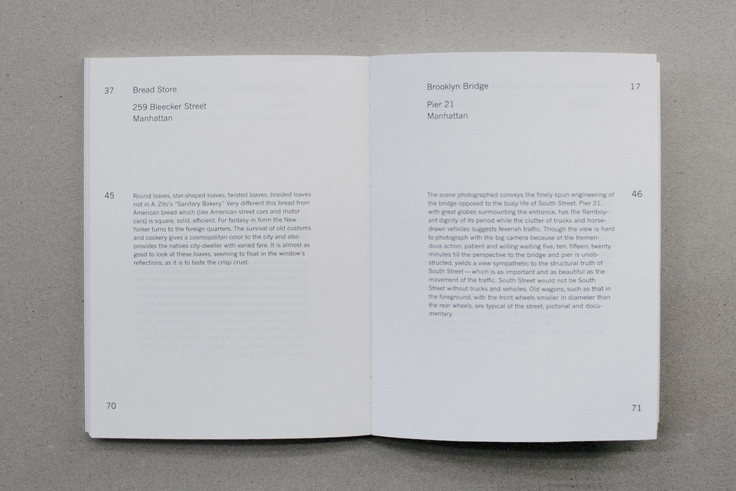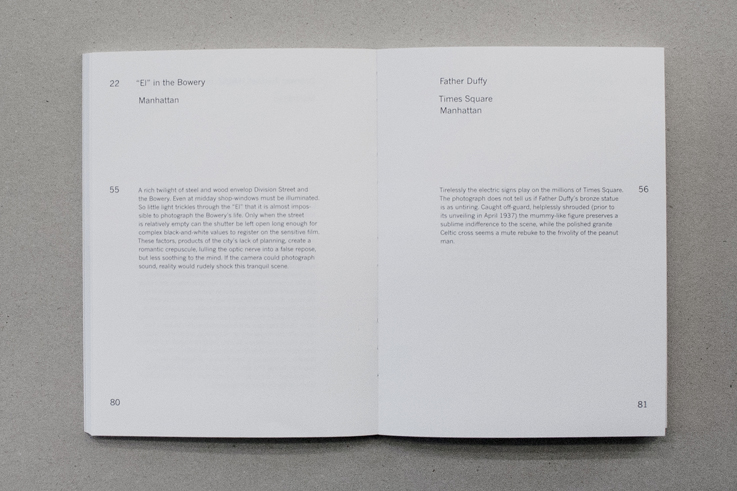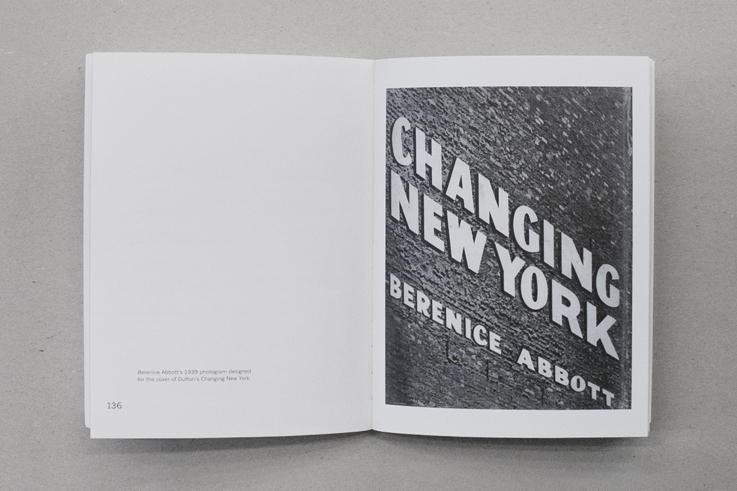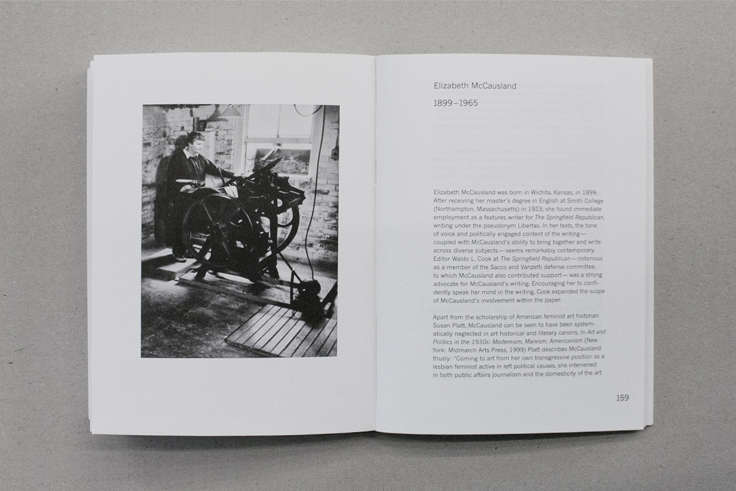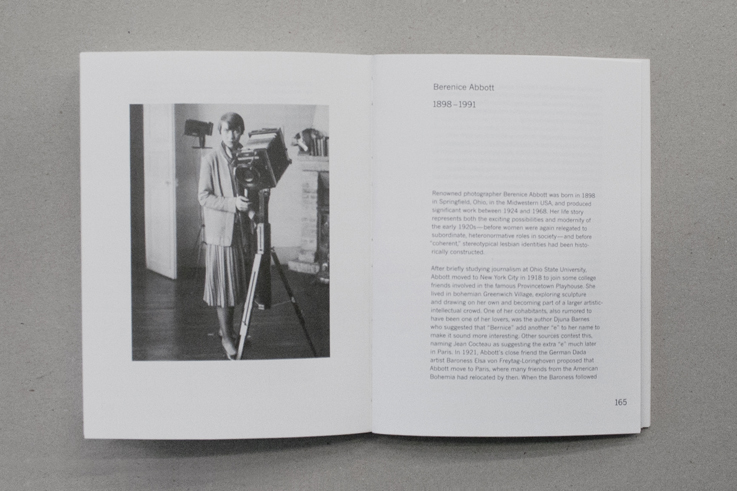Presseinformationen
Alice Maude-Roxby und Stefanie Seibold: Censored Realities / Changing New York
Infos
Alice Maude-Roxby und Stefanie Seibold: Censored Realities / Changing New York. The complete reclaimed texts of art critic and political journalist Elizabeth McCausland intended for photographer Berenice Abbott’s 1930s seminal book Changing New York
Mit Texten von Elizabeth McCausland, Zoe Leonard, Alice Maude-Roxby, Stefanie Seibold (eng.).
Redaktion: Joan Giroux, Sabine Weier.
Edition Camera Austria, Graz 2018.
186 Seiten, 16,5 × 22 cm, 15 SW-Abbildungen.
€ 19,– / ISBN 978-3-902911-39-1
Buchpräsentation
21. 12. 2018, 19:00
nGbK, Veranstaltungsraum, 1. OG, Oranienstraße 25, 10999 Berlin
Präsentation in englischer Sprache mit Stefanie Seibold und Alice Maude-Roxby, Moderation Sabine Weier
Pressedownloads

Pressetext
Die Forschung zu weiblichen/sapphischen Kollaborationen der Moderne deckt fortlaufende Prozesse der »Auslöschung« oder des »Aus-der-Kunstgeschichte-heraus-Schreibens« weiblicher Protagonistinnen auf. Ein Beispiel ist die von Dutton publizierte Buchausgabe des Projekts »Changing New York« der Fotografin Berenice Abbott und der Autorin Elizabeth McCausland aus dem Jahr 1939. Es ist kaum bekannt, dass Dutton sowohl die Originaltexte, die McCausland zu Abbotts Fotografien geschrieben hatte, als auch die von den beiden entwickelte innovative Text-Bild-Gestaltung ablehnte. Stattdessen entschied sich der Verlag für eine konservative Gestaltung und redigierte McCauslands Texte so radikal, dass lediglich knappe, inhaltsleere, mit den Originaltexten kaum mehr vergleichbare Bildunterschriften übrigblieben. So verflachte er auch die Sicht auf Abbotts Fotografien, die in der publizierten Version nur mehr wie Illustrationen eines New-York-Stadtführers erschienen.
Im Museum of the City of New York stießen Alice Maude-Roxby und Stefanie Seibold auf das vollständige Konvolut der Originaltexte, die Elizabeth McCausland, eine Kommunistin und sozialkritische Journalistin sowie langjährige Partnerin Abbotts, für das Buch geschrieben hatte. Im Archiv waren sie seit 1939 intakt und mehr oder weniger unberührt geblieben. Die kritischen Texte verorten die Fotografien im größeren politischen und sozialen Kontext der Großen Depression in den USA der 1930er-Jahre. In ihrem ursprünglichen Konzept hatten Abbott und McCausland die Texte und die Fotografien in Bezug auf die Produktion von Wissen und/oder als Werkzeug kritischer Reflexion in gleicher Weise gewürdigt. Das Buch sollte die erschütternden sozialen Bedingungen und Ungleichheiten des New Yorks der 1930er-Jahre kommentieren.
McCauslands vollständige Texte erscheinen nun erstmals in dem Buch Censored Realities /Changing New York in der Edition Camera Austria. Ein eigens für das Projekt konzipiertes Index-System ermöglicht es den Leser*innen, jeden der 100 Originaltexte den entsprechenden Fotografien Berenice Abbotts zuzuordnen, die in der ersten Changing New York-Ausgabe von Dutton und in späteren von Dover publiziert wurden. Ein ausführlicher Text und mehrere Originalbriefe geben Einblick in die Recherche der beiden Autorinnen und in die Geschichte dessen, was sie im Rahmen eines größeren Rechercheprojekts als »Sapphic Modernity« bezeichnen.
Auszug aus: Alice Maude-Roxby, Stefanie Seibold, “Sapphic Modernity”
This publication is part of a larger research base highlighting the contributions to modernism of women in general and non-heterosexual women in particular. One focus in our research considers collaborations by women in modernism, often as partners. The starting point for our project was an article by Canadian theorist and design-historian Jasmine Rault about two female (one American, one British) designers in Paris in the 1920s who met while one was writing an article about designer Eileen Gray’s work. Remarkable to us within Rault’s text is her striking statement about the strong connections she sees between women, modernism, and non-heterosexuality itself. Rault introduced us to the idea of: “the cultural field of Sapphic modernity … [as] a loose network of women who cultivated an intimate connection between female nonhetero sexuality and modernity itself, women for whom becoming nonheterosexual was synonymous with becoming modern.”¹ It is exactly this conflation of modernity with non-heterosexuality—avoiding all the later pitfalls of limiting identity constructions2²—that got us interested in the works of these often avant-garde, experimental but mostly marginalized art producers. So we started our investigation into modernism once again, this time considering all of modernism’s players, including those censored out or previously ignored.³
But our research is not so much interested in recuperating queer life stories—and we say queer even though the term queer is a willful anachronism when used to describe the period before gay liberation—but instead looks to trace the exclusion of queers, women, and others from art history to the very way in which modernist ideology is constructed against these figures. As Paul B. Preciado has argued: “Considered in the context of defining new techniques for producing sexual difference that characterized Central European biopolitics in the late nineteenth century, queer, kitsch, camp, and cursi, signal all that which exceeds the ‘new’ masculine figure of the virile, white, heterosexual man. The modern male, the true protagonist of the public space and political life, but also social player and artistic producer, is sketched out in disciplinary terms in opposition to the queer, cursi, the romantic, Baroque, the Oriental, domestic, southern, fetishist, sentimental, childish, feminine, the crazy, and the mannered.”4
The McCausland and Abbott collaboration is one part within a long period of research through which we have found many other fantastic, albeit marginalized and mostly devalued contributions by women to modernity. These significant yet neglected contributions form the content of our major forthcoming exhibition at John Hansard Gallery in 2019. In the framework of this project, a focus on the Abbott/McCausland collaboration is seen within the context of the editorial collaborations between Jane Heap and Margaret Anderson on The Little Review, the interior designs of Elizabeth Eyre de Lanux and Evelyn Wyld, amongst others.
This research then is driven by a queer-feminist interest and, as Jasmine Rault remarks, “its results poignantly represent both the presence and absence of queer histories, what theoretician Ann Cvetkovich describes as the ‘traumatic loss of history’ that marks contemporary queer subjects, politics, and publics.” Rault continues: “Despite over thirty years of ecuperative research to ‘prove’ the existence of queers in history (to prove that queers have a history) and to interrogate the place of sexual dissidents and dissidence in the cultural history of modernity itself, these histories and this field of scholarship and the contemporary art world are constantly on the brink of being lost.”5 We see our book project as an active statement against this ongoing and pervasive tendency of forgetting, marginalization, discrimination, and censorship.
¹ Jasmine Rault, “Losing Feelings: Elizabeth Eyre de Lanux and Her Affective Archive of Sapphic Modernity,” Archives of American Art Journal 48 (2009), pp. 56–65.
² Identity categories that, as Rault argues, made “these lives and identities less likely to be read as chic, avant-garde, and modern than degenerate, dangerous, and lesbian.” Ibid., p. 59.
³ Modernism and its male proponents and protagonists have been intensely revisited within the fine arts in the last two decades.
4 Paul B. Preciado, “The Ocaña We Deserve: Campceptualism, Sexual Insubordination, and Performative Politics,” in Ocaña, ed. Pedro G. Romero (Barcelona: Ediciones Polígrafa, 2012), pp. 412–38.
5 Rault, “Losing Feelings,” pp. 58–59.
Alice Maude-Roxbys Tätigkeiten als Autorin und Kuratorin sowie ihre fotografische Praxis sind in »live« und »ortsspezifisch« ausgeführte Untersuchungen von Fragen zur Fotografie- und Kunstgeschichte eingebettet. Diese umfassen Interviews und die Recherche in Archiven. Zu ihren Publikationen zählen Anti-Academy (John Hansard Gallery), Marcia Farquhar’s 12 Shooters (Live Art Development Agency), Performing Memory (Kunstraum Niederösterreich, Wien), Live Art on Camera (John Hansard Gallery), On Record: art, advertising and the actions of Gina Pane (Artwords Press) und »The Delicate Art of Documenting Performance« in: Art, Lies, and Videotapes: Exposing Performance (Tate Liverpool). Zusammen mit Stefanie Seibold erarbeitet sie derzeit das Ausstellungsprojekt »Sapphic Modernism: resist, be modern (again)«, zu sehen 2019 in der John Hansard Gallery. Sie ist Fine Art Programme Leader an der Middlesex University.
Stefanie Seibold ist eine in Wien ansässige Künstlerin. Sie arbeitet in den Bereichen Performance, Installation, Objekt, Archiv, Video, Sound und Text. Ihre Praxis umfasst zudem kuratorische Ansätze und Projekte. Sie ist Co-Autorin des Kompendiums Performance in Vienna since the 1960s, in dem bedeutende weibliche und queere Positionen präsentiert sind. Zusammen mit Alice Maude-Roxby erarbeitet sie derzeit das Ausstellungsprojekt »Sapphic Modernism/Transatlantic Crossings«. Ihre Arbeiten waren in unterschiedlichen Institutionen zu sehen, darunter das De Appel arts centre, Amsterdam, das 21er Haus, Wien, die Akademie der Künste, Berlin, Camera Austria, Graz, der Württembergische Kunstverein, Stuttgart. Derzeit lehrt sie an der Akademie der bildenden Künste in Wien Performancekunst und Bildhauerei.
Bildmaterial
Die honorarfreie Veröffentlichung ist nur in Zusammenhang mit der Berichterstattung über die Ausstellung und die Publikation gestattet. Wir ersuchen Sie die Fotografien vollständig und nicht in Ausschnitten wiederzugeben. Bildtitel als Download unter dem entsprechenden Link.

